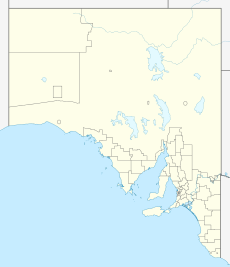Hopkins Creek Conservation Park facts for kids
Quick facts for kids Hopkins Creek Conservation ParkEmu Downs, South Australia |
|
|---|---|
|
IUCN Category VI (Managed Resource Protected Area)
|
|
| Nearest town or city | Burra |
| Established | 22 July 2010 |
| Area | 5.15 km2 (2.0 sq mi) |
| Managing authorities | Department for Environment and Water |
| See also | Protected areas of South Australia |
Hopkins Creek Conservation Park is a special protected area in the Australian state of South Australia. It's located in a place called Emu Downs. This park is about 125 kilometers northeast of Adelaide, the state capital. It's also about 21 kilometers south of the town of Burra.
The park is named after Hopkins Creek, a small stream found just north of its borders. It was officially created on 22 July 2010. This happened under a law called the National Parks and Wildlife Act 1972. The park covers an area of about 5.15 square kilometers.
Protecting Nature at Hopkins Creek
Hopkins Creek Conservation Park is a "protected area." This means it's a place where nature is kept safe. The main goal is to protect the plants and animals that live there. It's managed by the Department for Environment and Water.
Why Was the Park Created?
The park was established to look after important natural habitats. When it was created in 2010, a special rule was made. This rule allowed some existing activities, like mining, to continue. However, the park's main purpose remains conservation.
The Heysen Trail
A famous long-distance walking path, the Heysen Trail, runs along the southern edge of the park. This trail lets people explore the beautiful natural scenery. It's a great way to experience the Australian bush.
Special Plants in the Park
Hopkins Creek Conservation Park is home to some unique plants. One very important plant found here is the Acacia glandulicarpa, also known as the Hairy-pod Wattle.
The Hairy-pod Wattle
The Hairy-pod Wattle is a type of shrub. It grows in parts of western Victoria and eastern South Australia. This plant is quite rare. It is listed as endangered under the National Parks and Wildlife Act 1972. This means it's at high risk of disappearing forever. It's also considered vulnerable by another important law, the Commonwealth Environment Protection and Biodiversity Conservation Act 1999. Protecting areas like Hopkins Creek helps keep this special wattle safe.
How the Park is Classified
The park is classified by an organization called the IUCN. This group helps set standards for protected areas around the world.
IUCN Category VI Explained
Hopkins Creek Conservation Park is an IUCN Category VI protected area. This category means it's a protected area where natural resources can be used in a sustainable way. This allows some activities, but always with the main goal of protecting nature in the long term. It's about balancing human needs with conservation.


